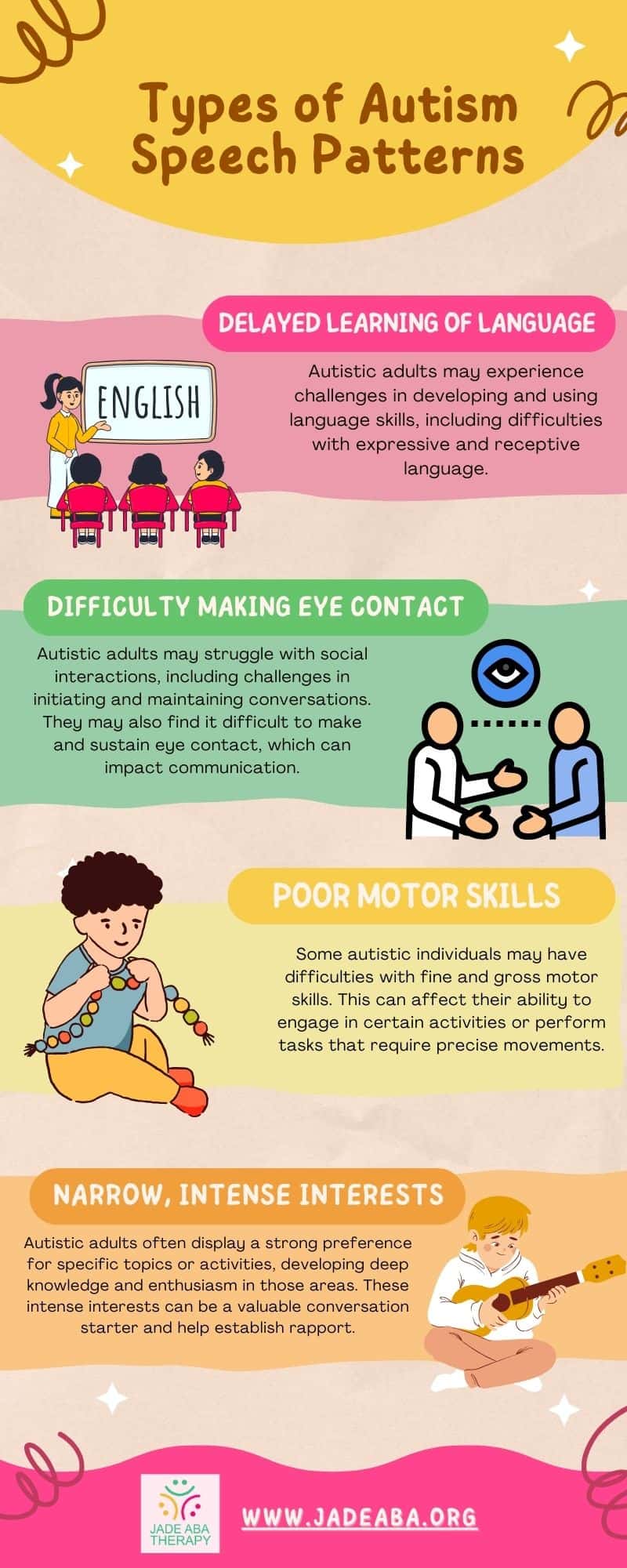Communicating with autistic adults requires the use of effective strategies that promote understanding and respect. Doing so allows you to create an environment that encourages meaningful communication and engagement.
One crucial aspect of effective communication with autistic adults is treating them with respect. It is important to remember that they are adults and should not be patronized or treated like children.
Using overfamiliar terms like “honey” or “sweetie” can be perceived as condescending, especially in a professional setting. Hence, we highly recommend sticking to more formal modes of address unless otherwise requested by the individual.

Maintaining Engagement through Interests
To effectively communicate with autistic adults, it is helpful to establish a connection through their special interests and hobbies. Discussing topics they are passionate about helps you maintain their attention and foster meaningful communication. Show genuine interest in their interests and allow them to share their knowledge and experiences.
Observing signs of engagement, such as eye contact or body language, is also crucial. Address them by name to create a personal connection. This helps to establish a sense of rapport and encourages them to actively participate in the conversation. Remember to be patient, understanding, and open-minded as each individual with autism may have different communication preferences and needs.

Language and Communication
Autistic adults often benefit from clear and specific language that avoids ambiguity and minimizes the use of metaphors, slang, or idioms. By using straightforward and concrete language, you can help them follow conversations more easily. Additionally, it is important to be mindful of your tone, ensuring that it remains respectful and non-judgmental.
To enhance communication clarity, consider the following tips:
- Speak at a moderate pace, allowing time for processing and understanding.
- Break down complex information into smaller, more manageable parts.
- Use visual aids, such as charts or diagrams, to support verbal communication.
- Provide clear instructions and expectations, using simple and concise language.
- Repeat and rephrase information if necessary, ensuring comprehension.
The use of clear and concise communication techniques helps you promote better understanding and reduce misunderstandings between yourself and autistic adults.
Handling Sensory Overload
Autistic individuals may experience sensory sensitivities which can lead to sensory overload in certain environments. Sensory overload occurs when the brain receives an overwhelming amount of sensory information, resulting in feelings of distress and discomfort. When communicating with autistic adults, it is essential to create an environment that minimizes sensory overload.
Make sure to consider the following strategies when addressing sensory overload:
- Minimize background noise or distractions that may be overwhelming.
- Be aware of potential triggers, such as bright lights, strong scents, or physical touch.
- Allow for breaks or time alone if needed to alleviate sensory overwhelm.
- Respect personal space and boundaries to help reduce anxiety.
Understanding the unique communication needs of autistic adults is essential for building meaningful connections and promoting inclusivity. By employing clear and concise language and addressing sensory overload, you can create an environment that fosters effective communication and enhances the well-being of autistic individuals.

Patience and Understanding
It is important to approach interactions with autistic adults with patience and understanding. ASD can affect communication and processing abilities, and this makes it essential to adapt our communication strategies to ensure effective and meaningful interactions.
Autistic adults may require additional time to process information and formulate their responses. Due to this, it’s essential to be patient and allow for pauses between phrases to allow them to absorb comments and gather their thoughts. Rushing or interrupting the individual’s processing time can lead to misunderstandings and hinder effective communication.
In some situations, an autistic adult may display distressed behavior during communication. It is crucial to respond to these behaviors with empathy and understanding. Using a behavior diary can help identify potential triggers or underlying causes of distress, allowing for more targeted support.
When an autistic individual is experiencing distress, it is important to offer alternative ways for them to express their discomfort, such as using visual aids or a communication device. Additionally, setting clear boundaries and explaining acceptable and unacceptable behaviors can help create a safe and supportive environment.
Addressing distressed behavior also involves active listening and understanding. Take the time to listen attentively and show that you genuinely care and support the individual. If there is a lack of understanding, asking follow-up questions to clarify the message can be helpful.
Understanding Autism Spectrum
To effectively communicate with autistic adults, it’s also essential to have an understanding of the behavioral characteristics and sensory sensitivities commonly associated with ASD. Autistic individuals exhibit a diverse range of behavioral characteristics that can vary from person to person.
Some common behavioral characteristics include the following:

Sensory sensitivities are another aspect of autism that can significantly impact communication. Autistic individuals may experience hyper-sensitivity (extremely high) or hypo-sensitivity (extremely low) to sensory stimuli. Some common sensitivities include:
- Bright lights – Some autistic adults may be highly sensitive to bright lights, finding them overwhelming or distracting. Creating a calm and well-lit environment can help facilitate communication.
- Physical touch – Autistic individuals may have varying levels of sensitivity to touch. Some may find certain types of touch uncomfortable or aversive. It’s important to be mindful of personal space and respect boundaries.
- Strong scents – Certain smells can be overpowering for autistic individuals, affecting their comfort and ability to focus. Minimizing the use of strong fragrances in the environment can create a more conducive space for communication.
Understanding these behavioral characteristics and sensory sensitivities can significantly improve communication with autistic adults. By being aware of these aspects, individuals can adapt their communication styles and create an environment that is more accommodating and supportive.
Remember, effective communication is a two-way process that requires patience, understanding, and flexibility. Taking the time to understand and respect the unique communication preferences and needs of autistic adults can foster meaningful connections and enhance the overall communication experience.